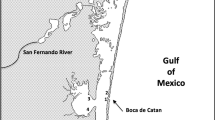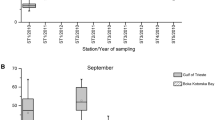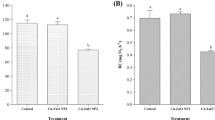Abstract
A 12-month active biomonitoring study was performed in 2008–2009 on the Vesle river basin (Champagne-Ardenne, France) using the freshwater mussel Dreissena polymorpha as a sentinel species; allochthonous mussels originating from a reference site (Commercy) were exposed at four sites (Bouy, Sept-Saulx, Fismes, Ardre) within the Vesle river basin. Selected core biomarkers (acetylcholinesterase (AChE) activity, glutathione-S transferase (GST) activity, metallothionein concentration), along with digestive enzyme activities (amylase, endocellulase) and energy reserve concentrations (glycogen, lipids), were monitored throughout the study in exposed mussels. At the Fismes and Ardre sites (downstream basin), metallic and organic contamination levels were low but still high enough to elicit AChE and GST activity induction in exposed mussels (chemical stress); besides, chemical pollutants had no apparent deleterious effects on mussel condition. At the Bouy and Sept-Saulx sites (upstream basin), mussels obviously suffered from adverse food conditions which seriously impaired individual physiological state and survival (nutritional stress); food scarcity had however no apparent effects on core biomarker responses. Digestive enzyme activities responded to both chemical and nutritional stresses, the increase in energy outputs (general adaptation syndrome—downstream sites) or the decrease in energy inputs (food scarcity—upstream sites) leading to mid- or long-term induction of digestive carbohydrase activities in exposed mussels (energy optimizing strategy). Complex regulation patterns of these activities require nevertheless the use of a multi-marker approach to allow data interpretation. Besides, their sensitivity to natural confounding environmental factors remains to be precised.








Similar content being viewed by others
References
Albentosa M, Moyano FJ (2008) Influence of nutritional stress on digestive enzyme activities in juveniles of two marine clam species, Ruditapes decussatus and Venerupis pullastra. J Sea Res 59:249–258
Allison N, Millward GE, Jones MB (1998) Particle processing by Mytilus edulis: effects on bioavailability of metals. J Exp Mar Biol Ecol 222:149–162
Amiard JC, Amiard-Triquet C, Barka S, Pellerin J, Rainbow PS (2006) Metallothioneins in aquatic invertebrates: their role in metal detoxification and their use as biomarkers. Aquat Toxicol 76:160–202
Bacchetta R, Mantecca P (2009) DDT polluted meltwater affects reproduction in the mussel Dreissena polymorpha. Chemosphere 76:1380–1385
Baines SB, Fisher NS, Cole JJ (2007) Dissolved organic matter and persistence of the invasive zebra mussel (Dreissena polymorpha) under low food conditions. Limnol Oceanogr 52:70–78
Barfield ML, Farris JL, Black MC (2001) Biomarker and bioaccumulation responses of asian clams exposed to aqueous cadmium. J Toxicol Environ Health A 63:495–510
Bernfeld P (1955) Amylases, α and β. In: Colowick SP, Kaplan NO (eds) Methods in enzymology, vol 1. Academic Press, New York, pp 149–158
Bervoets L, Voets J, Covaci A, Chu S, Qadah D, Smolders R, Schepens P, Blust R (2005) Use of transplanted zebra mussels (Dreissena polymorpha) to assess the bioavailability of microcontaminants in Flemish surface waters. Environ Sci Technol 39:1492–1505
Binelli A, Ricciardi F, Riva C, Provini A (2005) Screening of POP pollution by AChE and EROD activities in zebra mussels from the Italian Great Lakes. Chemosphere 61:1074–1082
Binelli A, Cogni D, Parolini M, Provini A (2010) Multi-biomarker approach to investigate the state of contamination of the R. Lambro/R. Po confluence (Italy) by zebra mussel (Dreissena polymorpha). Chemosphere 79:518–528
Björk M (1995) Bioavailability and uptake of hydrophobic organic contaminants in bivalve filter-feeders. Ann Zool Fenn 32:237–245
Bocquené, G., Galgani, F., 2004. Méthodes d’analyse en milieu marin – Les marqueurs biologiques des effets de polluants : l’acétylcholinestérase. Ifremer, Plouzané
Boldina-Cosqueric I, Amiard JC, Amiard-Triquet C, Dedourge-Geffard O, Métais I, Mouneyrac C, Moutel B, Berthet B (2010) Biochemical, physiological and behavioural markers in the endobenthic bivalve Scrobicularia plana as tools for the assessment of estuarine sediment quality. Ecotoxicol Environ Saf 73:1733–1741
Borcherding J (1992) Another early warning system for the detection of toxic discharges in the aquatic environment based on valve movements of the freshwater mussel Dreissena polymorpha. In: Neumann D, Jenner HA (eds) The zebra mussel Dreissena polymorpha: ecology, biological monitoring and first applications in the water quality management–Limnologie aktuell, vol 4. Gustav Fischer Verlag, pp 127–146
Bourgeault A, Gourlay-Francé C, Vincent-Hubert F, Palais F, Geffard A, Biagianti-Risbourg S, Pain-Devin S, Tusseau-Vuillemin MH (2010) Lessons from a transplantation of zebra mussels into a small urban river: an integrated ecotoxicological assessment. Environ Toxicol 25:468–478
Bradford MM (1976) A rapid and sensitive method for quantification of microgram quantities of protein utilizing the principle of protein-dye binding. Anal Biochem 72:248–254
Brdička A (1933) Polarographic studies with the dropping mercury method. A new test for proteins in the presence of cobalt salts in ammoniacal solution of ammonium chloride. Collect Czechoslov Chem Commun 5:112–128
Brock A, Brock V (1989) Kinetics of amylase, cellulase and laminarinase in four commercially important bivalves. In: Klekowski RZ, Styczyńska-Jurewicz E, Falkowski L (eds) Proceedings of the 21st European Marine Biology Symposium, Gdańsk, 14-19 September 1986. Zakład Narodowy im. Ossolińskich, pp 31–40
Brock V, Kennedy VS (1992) Quantitative analysis of crystalline style carbohydrases in five suspension- and deposit-feeding bivalves. J Exp Mar Biol Ecol 159:51–58
Brock V, Kennedy VS, Brock A (1986) Temperature dependency of carbohydrase activity in the hepatopancreas of thirteen estuarine and coastal bivalve species from the North American east coast. J Exp Mar Biol Ecol 103:87–101
Calow P, Sibly R (1990) A physiological basis population processes: ecotoxicological implications? Funct Ecol 4:283–288
Camusso M, Balestrini R, Binelli A (2001) Use of zebra mussel (Dreissena polymorpha) to assess trace metal contamination in the largest Italian subalpine lakes. Chemosphere 44:263–270
Carr RS, Neff JM (1984) Quantitative semi-automated enzymatic assay for tissue glycogen. Comp Biochem Physiol B 77:447–449
Chen Z, Mayer LM, Weston DP, Bock MJ, Jumars PA (2002) Inhibition of digestive enzyme activities by copper in the guts of various marine benthic invertebrates. Environ Toxicol Chem 21:1243–1248
Contardo-Jara V, Krueger A, Exner HJ, Wiegand C (2009) Biotransformation and antioxidant enzymes of Dreissena polymorpha for detection of site impact in watercourses of Berlin. J Environ Monitor 11:1147–1156
Corsi I, Pastore AM, Lodde A, Palmerini E, Castagnolo L, Focardi S (2007) Potential role of cholinesterases in the invasive capacity of the freshwater bivalve Anodonta woodiana (Bivalvia: Unionacea): a comparative study with the indigenous species of the genus Anodonta sp. Comp Biochem Physiol C 145:413–419
Coughlan J (1969) Estimation of filtering rate from clearance of suspensions. Mar Biol 2:356–358
Dauberschmidt C, Dietrich DR, Schlatter C (1997) Esterases in the zebra mussel Dreissena polymorpha: activities, inhibition, and binding to organophosphates. Aquat Toxicol 37:295–305
Davison W, Zhang H (1994) In situ speciation measurements of trace components in natural waters using thin-film gels. Nature 367:546–548
De Coen WM, Janssen CR (1997) The use of biomarkers in Daphnia magna toxicity testing. II. Digestive enzyme activity in Daphnia magna exposed to sublethal concentrations of cadmium, chromium and mercury. Chemosphere 35:1053–1067
De Coen WM, Janssen CR, Giesy JP (2000) Biomarker applications in ecotoxicology: bridging the gap between toxicology and ecology. In: Persoone G, Janssen C, De Coen WM (eds) New microbiotests for routine toxicity screening and biomonitoring. Kluwer Academic, Plenum Publishers, New York, pp 13–25
de Lafontaine Y, Gagné F, Blaise C, Costan G, Gagnon P, Chan HM (2000) Biomarkers in zebra mussels (Dreissena polymorpha) for the assessment and monitoring of water quality of the St Lawrence River (Canada). Aquat Toxicol 50:51–71
Dedourge-Geffard O, Palais F, Biagianti-Risbourg S, Geffard O, Geffard A (2009) Effects of metals on feeding rate and digestive enzymes in Gammarus fossarum: an in situ experiment. Chemosphere 77:1569–1576
Dethloff GM, Schlenk D, Hamm JT, Bailey HC (1999) Alterations in physiological parameters of rainbow trout (Oncorhynchus mykiss) with exposure to copper and copper/zinc mixtures. Ecotoxicol Environ Saf 42:253–264
DREAL Champagne-Ardenne (2010) Eaux et milieu aquatiques, Qualité des eaux, Eaux de surface, Les données sur la qualité de l’eau en Champagne-Ardenne en 2008. http://www.champagne-ardenne.developpement-durable.gouv.fr
Ellman GL, Courtney KD, Andres jr V, Featherstone RM (1961) A new and rapid colorimetric determination of acetylcholinesterase activity. Biochem Pharmacol 7:88–95
Escartin E, Porte C (1997) The use of cholinesterase and carboxylesterase activities from Mytilus galloprovincialis in pollution monitoring. Environ Toxicol Chem 16:2090–2095
Faria M, Carrasco L, Diez S, Riva MC, Bayona JM, Barata C (2009) Multi-biomarker responses in the freshwater mussel Dreissena polymorpha exposed to polychlorobiphenyls and metals. Comp Biochem Physiol C 149:281–288
Faria M, López MA, Díez S, Barata C (2010) Are native naiads more tolerant to pollution than exotic freshwater bivalve species? An hypothesis tested using physiological responses of three species transplanted to mercury contaminated sites in the Ebro River (NE, Spain). Chemosphere 81:1218–1226
Farris J, Grudzien J, Belanger S, Cherry D, Cairns J (1994) Molluscan cellulolytic activity responses to zinc exposure in laboratory and field stream comparisons. Hydrobiologia 287:161–178
Fernández-Reiriz MJ, Labarta U, Navarro JM (2004) Feeding and digestive response of Argopecten purpuratus to short-term variation in food quality and quantity. Aquaculture 237:347–364
Frings CS, Fendley TW, Dunn RT, Queen CA (1972) Improved determination of total serum lipids by the sulfophosphovanillin. Clin Chem 18:673–674
Habig WH, Pabst MJ, Jakoby WB (1974) Glutathione S transferases. The first enzymatic step in mercapturic acid formation. J Biol Chem 249:7130–7139
Huckins JN, Tubergen MW, Manuweera GK (1990) Semi-permeable membrane devices containing model lipid: a new approach to monitoring the bioavailability of lipophilic contaminants and estimating their bioconcentration potential. Chemosphere 20:533–552
Ibarrola I, Larretxea X, Iglesias JIP, Urrutia MB, Navarro E (1998a) Seasonal variation of digestive enzyme activities in the digestive gland and the crystalline style of the common cockle Cerastoderma edule. Comp Biochem Physiol A 121:25–34
Ibarrola I, Navarro E, Iglesias JIP (1998b) Short-term adaptation of digestive processes in the cockle Cerastoderma edule exposed to different food quantity and quality. J Comp Physiol B 168:32–40
Ivanković D, Pavičić J, Beatović V, Klobučar RS, Klobučar GI (2009) Inducibility of metallothionein biosynthesis in the whole soft tissue of zebra mussels Dreissena polymorpha exposed to cadmium, copper, and pentachlorophenol. Environ Toxicol 25:198–211
Jantz B, Neumann D (1998) Growth and reproductive cycle of the zebra mussel in the River Rhine as studied in a river bypass. Oecologia 114:213–225
Johnson MA, Paulet YM, Donval A, Le Pennec M (1996) Histology, histochemistry and enzyme biochemistry in the digestive system of the endosymbiont-bearing bivalve Loripes lucinalis (Lamarck). J Exp Mar Biol Ecol 197:15–38
Jonsson CM, Aoyama H (2010) Effect of copper on the activation of the acid phosphatase from the green algae Pseudokirchneriella subcapitata. Biometals 23:93–98
Kalman J, Palais F, Amiard JC, Mouneyrac C, Muntz A, Blasco J, Riba I, Amiard-Triquet C (2009) Assessment of the health status of populations of the ragworm Nereis diversicolor using biomarkers at different levels of biological organisation. Mar Ecol Prog Ser 393:55–67
Kraak MH, Lavy D, Toussaint M, Schoon H, Peeters WH, Davids C (1993) Toxicity of heavy metals to the zebra mussel (Dreissena polymorpha). In: Nalepa TF, Schloesser DW (eds) Zebra mussels: biology, impacts and control. CRC Press, Boca Raton, pp 491–502
Labarta U, Fernández-Reiriz M, Navarro J, Velasco A (2002) Enzymatic digestive activity in epifaunal (Mytilus chilensis) and infaunal (Mulinia edulis) bivalves in response to changes in food regimes in a natural environment. Mar Biol 140:669–676
Lambert C, Moal J, Le Moullac G, Pouvreau S (2008) Mortality risks associated with physiological traits of oysters during reproduction. In: Samain JF, McCombie H (eds) Summer mortality of Pacific oyster Crassostrea gigas. The Morest Project. Editions Quae, Versailles, pp 63–106
Le Bihan E, Perrin A, Koueta N (2004) Development of a bioassay from isolated digestive gland cells of the cuttlefish Sepia officinalis L. (Mollusca Cephalopoda): effect of Cu, Zn and Ag on enzyme activities and cell viability. J Exp Mar Biol Ecol 309:47–66
Le Pennec G, Le Pennec M (2003) Induction of glutathione-S-transferases in primary cultured digestive gland acini from the mollusk bivalve Pecten maximus (L.): application of a new cellular model in biomonitoring studies. Aquat Toxicol 64:131–142
Li N, Zhao Y, Yang J (2008) Effects of water-borne copper on digestive and metabolic enzymes of the giant freshwater prawn Macrobrachium rosenbergii. Arch Environ Contam Toxicol 55:86–93
Marie V, Gonzalez P, Baudrimont M, Bourdineaud JP, Boudou A (2006) Metallothionein response to cadmium and zinc exposures compared in two freshwater bivalves, Dreissena polymorpha and Corbicula fluminea. Biometals 19:399–407
Marigómez I, Soto M, Carajaville MP, Angulo E, Giambérini L (2002) Cellular and subcellular distribution of metals in molluscs. Microsc Res Tech 56:358–392
McMahon RF (1996) The physiological ecology of the zebra mussel, Dreissena polymorpha, in North America and Europe. Am Zool 36:339–363
Mersch J (1993) Modalités d’utilisation de la moule zébrée Dreissena polymorpha en tant qu’indicateur biologique de la contamination des écosystèmes d’eau douce par les métaux lourds – Comparaison avec un autre type d’organisme sentinel, les mousses aquatiques. Thèse de doctorat. Université de Metz, France
Milam CD, Farris JL (1998) Risk identification associated with iron-dominated mine discharges and their effect upon freshwater bivalves. Environ Toxicol Chem 17:1611–1619
Minier C, Abarnou A, Jaouen-Madoulet A, Le Guellec AM, Tutundjian R, Bocquené G, Leboulenger F (2006) A pollution-monitoring pilot study involving contaminant and biomarker measurements in the Seine Estuary, France, using zebra mussels (Dreissena polymorpha). Environ Toxicol Chem 25:112–119
Mora P, Michel X, Narbonne JF (1999) Cholinesterase activity as a potential biomarker in two bivalves. Environ Toxicol Pharmacol 7:253–260
Morton BS (1983) Feeding and digestion in Bivalvia. In: Saleuddin ASM, Wilbur KM (eds) The Mollusca. Academic Press, New York, pp 65–147
Moulton CA, Fleming WJ, Purnell CE (1996) Effects of two cholinesterase-inhibiting pesticides on freshwater mussels. Environ Toxicol Chem 15:131–137
Mourgaud Y, Martinez E, Geffard A, Andral B, Stanisiere JY, Amiard JC (2002) Metallothionein concentration in the mussel Mytilus galloprovincialis as a biomarker of response to metal contamination: validation in the field. Biomarkers 7:479–490
Najimi S, Bouhaimi A, Daubèze M, Zekhnini A, Pellerin J, Narbonne JF, Moukrim A (1997) Use of acetylcholinesterase in Perna perna and Mytilus galloprovincialis as a biomarker of pollution in Agadir Marine Bay (South of Morocco). Bull Environ Contam Toxicol 58:901–908
Osman AM, Van Den Heuvel H, Van Noort PCM (2007) Differential responses of biomarkers in tissues of a freshwater mussel, Dreissena polymorpha, to the exposure of sediment extracts with different levels of contamination. J Appl Toxicol 27:51–59
Palais F, Jubeaux G, Dedourge-Geffard O, Biagianti-Risbourg S, Geffard A (2010) Amylolytic and cellulolytic activities in the crystalline style and the digestive diverticulae of the freshwater bivalve Dreissena polymorpha (Pallas, 1771). Molluscan Res 30:29–36
Palais F, Mouneyrac C, Dedourge-Geffard O, Giambérini L, Biagianti-Risbourg S, Geffard A (2011) One-year monitoring of reproductive and energy reserve cycles in transplanted zebra mussels (Dreissena polymorpha). Chemosphere 83:1062–1073
Prest HF, Jarman WM, Burns SA, Weismueller T, Martin M, Huckins JN (1992) Passive water sampling via Semi-Permeable Membrane Devices (SPMDs) in concert with bivalves in the Sacramento/San Joaquin River delta. Chemosphere 25:1811–1823
Ramcharan CW, Padilla DK, Dodson SI (1992) Models to predict potential occurrence and density of the zebra mussel, Dreissena polymorpha. Can J Fish Aquat Sci 49:2611–2620
Romani R, Antognelli C, Baldracchini F, De Santis A, Isani G, Giovannini E, Rosi G (2003) Increased acetylcholinesterase activities in specimens of Sparus auratus exposed to sublethal copper concentrations. Chem Biol Interact 145:321–329
Roméo M, Giambérini L (2008) Historique. In: Amiard JC, Amiard-Triquet C (eds) Les biomarqueurs dans l’évaluation de l’état écologique des milieux aquatiques. Lavoisier, Tec & Doc, Paris, pp 17–54
Rouxel-David E, Cordonnier G, Dachy S (2002) Synthèse des études menées sur le basin versant du champ captant de Couraux (Marne). Rapport BRGM/RP-51739-FR
Ruelas-Inzunza JR, Paez-Osuna F (2000) Comparative bioavailability of trace metals using three filter-feeder organisms in a subtropical coastal environment (Southeast Gulf of California). Environ Pollut 107:437–444
Schneider DW (1992) A bioenergetics model of zebra mussel, Dreissena polymorpha, growth in the Great Lakes. Can J Fish Aquat Sci 49:1406–1416
SCOR-UNESCO (1966) Determination of photosynthetic pigments in sea-water. UNESCO Monographs on Oceanographic Methodology, no. 1
Selye H (1976) Stress in health and disease. Butterworth Publishers, Boston
Thompson JAJ, Cosson RP (1984) An improved electrochemical method for the quantification of metallothioneins in marine organisms. Mar Environ Res 11:137–152
Tusseau-Vuillemin MH, Gourlay C, Lorgeoux C, Mouchel JM, Buzier R, Gilbin R, Seidel JL, Elbaz-Poulichet F (2007) Dissolved and bioavailable contaminants in the Seine river basin. Sci Total Environ 375:244–256
Valbonesi P, Sartor G, Fabbri E (2003) Characterization of cholinesterase activity in three bivalves inhabiting the North Adriatic sea and their possible use as a sentinel organisms for biosurveillance programmes. Sci Total Environ 312:79–88
Viarengo A, Ponzano E, Dondero F, Fabbri R (1997) A simple spectrophotometric method for metallothionein evaluation in marine organisms: an application to Mediterranean and Antarctic molluscs. Mar Environ Res 44:69–84
Voets J, Talloen W, de Tender T, van Dongen S, Covaci A, Blust R, Bervoets L (2006) Microcontaminant accumulation, physiological condition and bilateral asymmetry in zebra mussels (Dreissena polymorpha) from clean and contaminated surface waters. Aquat Toxicol 79:213–225
Wong WH, Cheung SG (2001) Feeding rates and scope for growth of green mussels, Perna viridis (L.) and their relationship with food availability in Kat O, Hong Kong. Aquaculture 193:123–137
Xuereb B, Chaumot A, Mons R, Garric J, Geffard O (2009) Acetylcholinesterase activity in Gammarus fossarum (Crustacea Amphipoda): intrinsic variability, reference levels, and a reliable tool for field surveys. Aquat Toxicol 93:225–233
Yan T, Teo LH, Sin YM (1996) Effects of metals on alpha-amylase activity in the digestive gland of the green mussel, Perna viridis L. Bull Environ Contam Toxicol 56:677–682
Zorita I, Ortiz-Zarragoitia M, Soto M, Cajaraville MP (2006) Biomarkers in mussels from a copper site gradient (Visnes, Norway): an integrated biochemical, histochemical and histological study. Aquat Toxicol 78:S109–S116
Acknowledgments
This PhD work was supported by grants from the ‘Région Champagne-Ardenne’ (Contrat de Projets Etat-Région, programme AQUAL) and from the ‘Programme Interdisciplinaire de Recherche sur l’Environnement de la Seine’ (PIREN-Seine). The authors gratefully acknowledge Mrs. Françoise Gourdon, Mrs. Antoinette Meyer, Mrs. Laurence Delahaut, M. Antoine Portelette and M. Ali Jaffal for kind help and support.
Author information
Authors and Affiliations
Corresponding author
Electronic supplementary material
Below is the link to the electronic supplementary material.
Rights and permissions
About this article
Cite this article
Palais, F., Dedourge-Geffard, O., Beaudon, A. et al. One-year monitoring of core biomarker and digestive enzyme responses in transplanted zebra mussels (Dreissena polymorpha). Ecotoxicology 21, 888–905 (2012). https://doi.org/10.1007/s10646-012-0851-1
Accepted:
Published:
Issue Date:
DOI: https://doi.org/10.1007/s10646-012-0851-1




